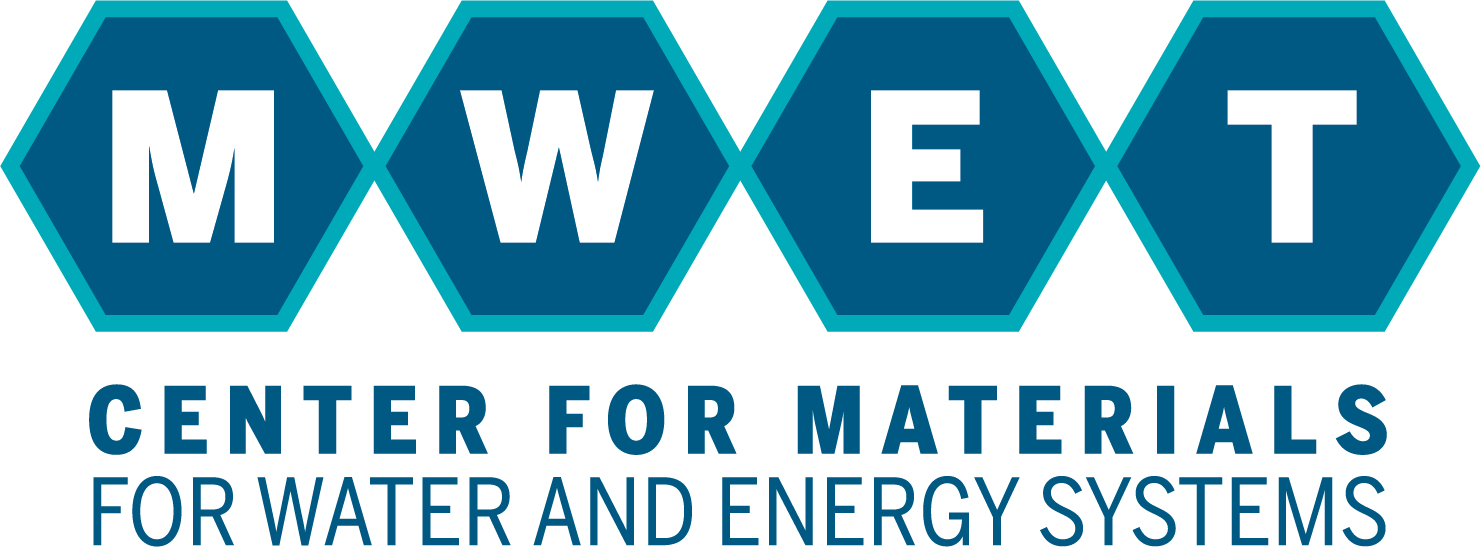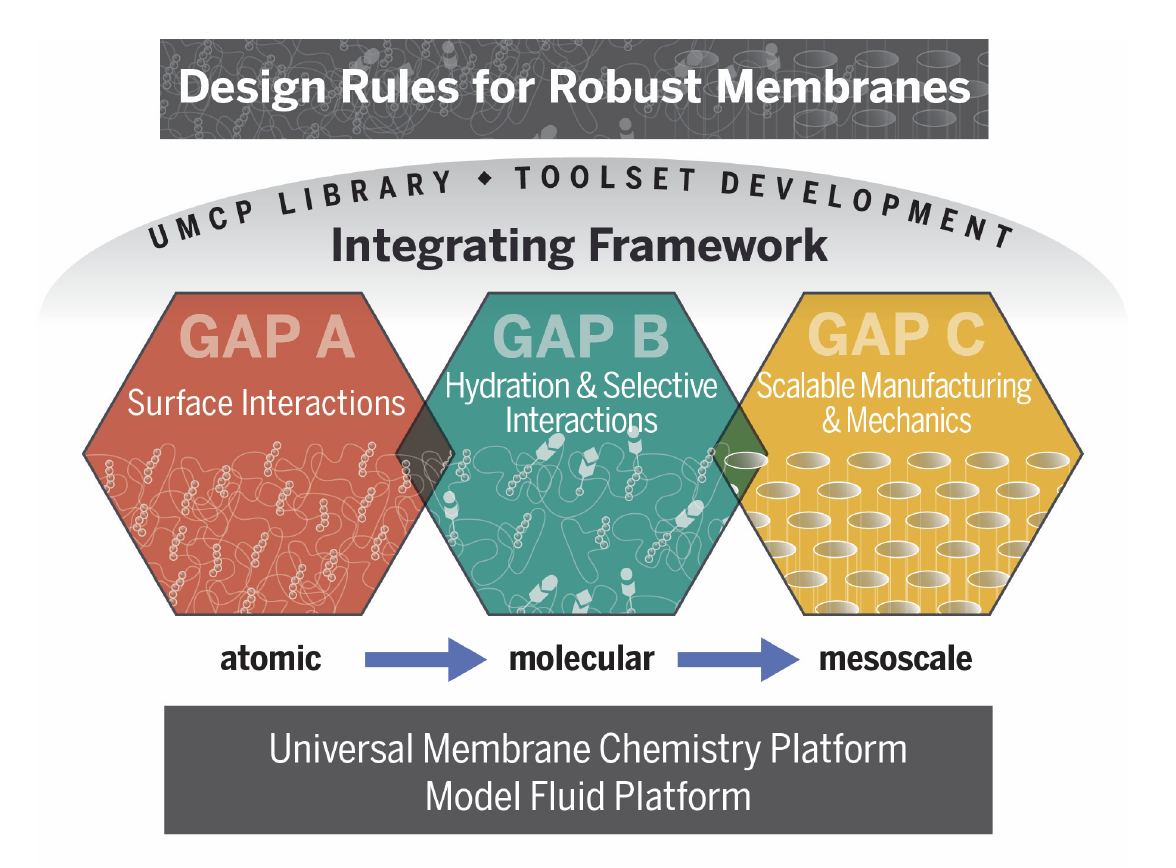
Fig. 1.1. M-WET scientific framework, illustrating the proposed Gap Attack Platforms (GAPs) and Integrating Framework (IF) designed to uncover impacts of molecular/mesoscale water, solute, and polymer interactions on membrane properties. These GAPs are built on a foundation of a shared universal membrane chemistry platform (UMCP) and model fluid platform (MFP).
Bridging Between Systems/Developing the Bridging Toolset
IF Co-Leaders:
UT Austin: Nate Lynd
UC Santa Barbara: Phillip Christopher
IF Co-Investigators:
UT Austin: Manish Kumar, Lynn Katz, Zak Page
UC Santa Barbara: Rachel Segalman, Craig Hawker, Todd Squires
Lawrence Berkeley National Laboratory Advanced Light Source: Greg Su, Ethan Crumlin, Dylan McReynolds
The Integrating Framework provides the foundation that connects GAPs
M-WET interrogates fundamental processes essential for purification of fit-for-purpose water from alternative water sources via a highly interdisciplinary research coalition. The Integrating Framework (IF) will create the materials (UMCP) libraries and state-of-the-art characterization and data science tools to enable and harmonize the discoveries across the Center. A key activity of the IF is the synthesis, scale-up, and documentation of the Universal Membrane Chemistry Platform (UMCP) (Fig. 1.2, above) in Project 1 to form an expansive materials library for the GAPs. Using materials from this library, the GAPs will create new molecular scale understanding of the structure and dynamics of water and solutes near membrane interfaces, design rules to control selectivity, and strategies for membrane formation. These fundamental discoveries will in turn allow the IF to evolve the UMCP to include more robust, scalable polymer chemistries, membrane formation strategies, and significant improvements in macroscopic membrane performance. The IF will also develop characterization tools with high-throughput (Project 2) as well as in situ and operando (Projects 3 and 4) capabilities to guide synthesis, simulation, and theory within the GAPs. Finally, a membrane characterization team led by Lab Manager Gleason will be responsible for physical and chemical characterization of membrane properties including solute and water solubility, diffusivity, permeability, ionic conductivity, dielectric properties, and mechanical properties of nonporous membranes. The team will also study flux, rejection, fouling, pore size, pore size distribution, surface energy, and mechanical properties of porous membranes. Vibrational spectroscopy, X-ray scattering, and electron microscopy will also be employed to characterize virgin and fouled membranes. These bridging toolsets connect fundamental molecular-level membrane interactions and assemblies developed in the GAPs to system-level membrane separation and fouling-resistant performance and energy efficiency through tools that span many length and time scales. Moreover, the multiscale suite of synchrotron X-ray tools is central to the IF’s ability to translate and connect discoveries at the molecular level across GAPs and address separations across the MFP (Fig. 1.3). The IF and M-WET team will develop and have access to unique characterization tools across length scales (Fig. 5.1, (below) through multiple user facility proposals. This includes an ongoing Approved Program and general user proposals at the ALS, a general user proposal at the National Synchrotron Light Source II (NSLS-II), and a user project at the Molecular Foundry to directly simulate X-ray spectroscopy. Finally, in collaboration with ALS, we are developing a shared M-WET Data Portal to house raw data (synchrotron and non-synchrotron) and searchable metadata to facilitate access to results across M-WET (McReynolds). This database is described in more detail in the Data Management Plan.
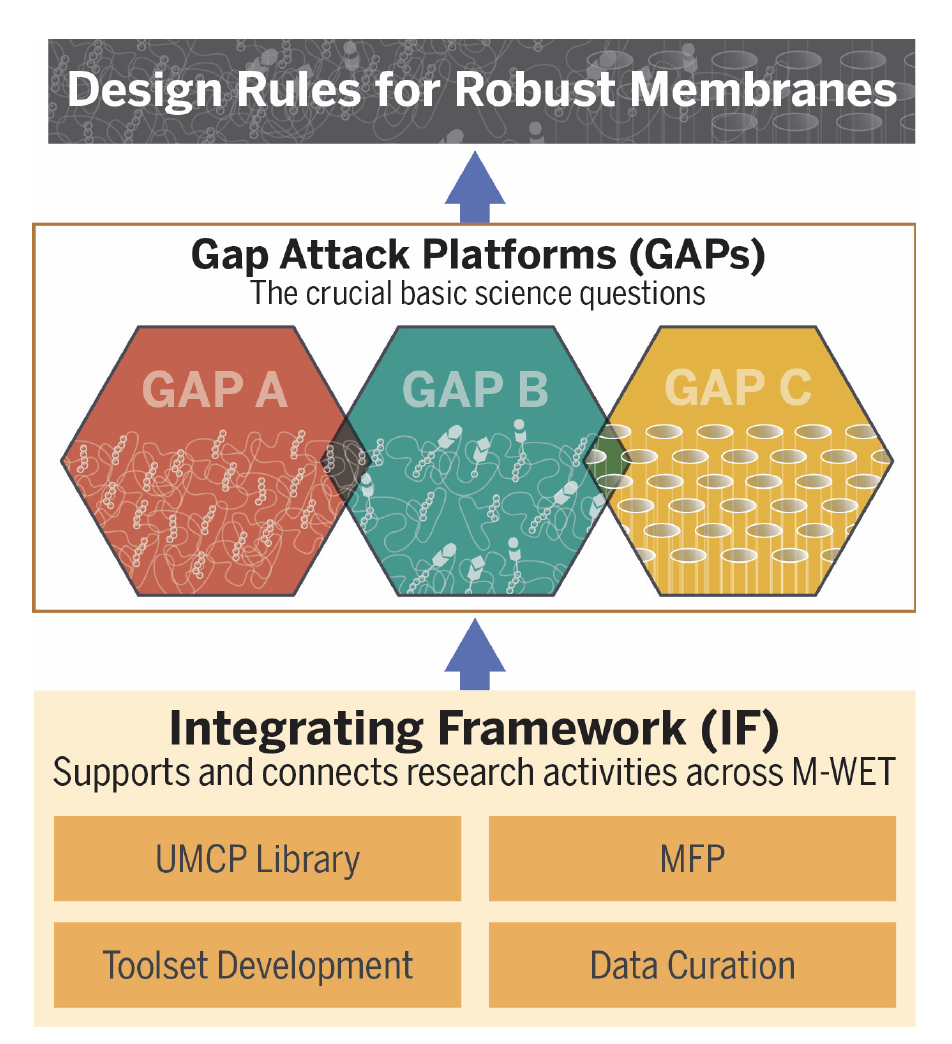
Fig. 5.1. The IF will support and connect research activities across all GAPs within M-WET, curating our UMCP library, MFP, and Database activities. The IF will also develope new tools both at Advanced Light Source at Lawrence Berkeley National Laboratory and via high-throughput characterization tool development at the University of California Santa Barbara and The University of Texas at Austin.
IF, Project 1: Synthesis and scale-up of UMCP materials
The original porous UMCP platform has evolved into a more mechanically robust construct, with a molecular architecture optimized for improved mechanical strength and non-equilibrium processing into isoporous morphologies. We use controlled anionic polymerization techniques to create a polystyrene-bpoly(ethylene-alt-propylene)-b-poly(styrene)-b-poly[(ethylene oxide)-co-(allyl glycidyl ether)] (PS1-b- PEP-b-PS2-b-P(EO-co-AGE)) material that exhibits substantially improved mechanical properties, referenced earlier in Fig. 1.2. We refer to the blocks sequentially as S1, EP, S2, and OX. Each component has a distinct purpose, with S1 (e.g., styrene) providing a molecular anchor, EP (e.g., ethylene/propylene) inserting toughness and strength, S2 (e.g., styrene) providing the requisite modulus to maintain a nanoscopic pore, and OX creating controlled hydrophilicity channels and functionality to attach interactants. Similarly, we have developed within M-WET a second non-porous UMCP platform based on copolymers of poly(ethylene glycol) acrylates and pentafluorophenyl acrylate (PFPA) that can be functionalized postpolymerization by a wide variety of functional groups (FGs). Each GAP addresses different portions of the UMCP architectures: GAP A focuses on understanding the role of FGs on controlling water dynamics and solute interactions, GAP B focuses on the fundamentals of designing new membrane materials for selectivity by incorporating specific bonds, and GAP C focuses on the S1-EP-S2 sub-architecture.
Syntheses of new UMCP variants will be performed by a Polymer Synthesis Scientist (Louise Kuehster) supervised by Lynd and Page at UT Austin using anionic and catalytic polymerization of vinyl and epoxide monomers for the porous platform and free radical routes for the non porous platform. A part-time project scientist at UCSB (supervised by Segalman and Hawker) will focus on the functionalization of both porous and nonporous UMCP materials. A specialized array of reactor glassware is available and tailored to scale-up to a 100–1000 g scale (Fig. 5.2). Materials will be synthesized, precipitated, dried, and placed in cold storage, then characterized within Project 3 for all parameters that affect processing and morphology, including overall molecular weight, molecular weight distribution, size of each block (S1, EP, S2, OX), and functional group (FG) identity. The molecular and morphological parameters will be stored in a database and made accessible to co-workers in all GAPs so that materials may be requested based on molecular and morphological characteristics, such as composition, molecular weight, pore size, spacing, morphology, and pore-size distribution, as described in our Data Management Plan.
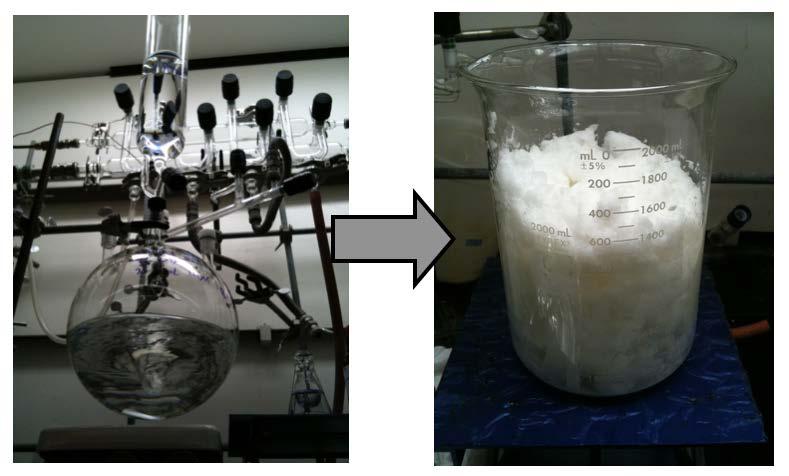
Fig 5.2. Large-scale (8L) reactor (left) and resultant unpurified polymer material (right).
IF, Project 2: High-throughput Measurements of Membrane-solute Interactions and Macroscopic Characterization
Making effective use of the UMCP material library to design functional membranes requires rapid screening of interactions with solutes. High-throughput experiments will be used to characterize the sorption capacity, selectivity, and permeability of solutes at varying concentrations and feed complexities. Initial efforts to develop high-throughput methodologies in M-WET have focused on:
- UV-vis spectrophotometry on 96 well plates to measure solute sorption/desorption from hydrogels and
- online robotic sampling approaches to measure the membrane permeability of salt mixtures that have significantly different permeabilities and potential interactions between salt sorption processes.
Additionally, robotic methodology (e.g., via a Chemspeed robot) will allow polymer dope casting variables, such as solvent ratios and polymer concentration, to be systematically, rapidly, and accurately varied over wide ranges to determine their influence on final membrane morphology, accelerating the navigation of this complex phase space to identify compositions of interest for isoporous membrane formation.
As an example, we have synthesized ligand functionalized hydrogels based on the non-porous UMCP in a 96 well plate format, as shown in Fig. 5.3, with varying imidazole (ligand) concentrations. This array of hydrogels was then tested for sorption of salts (CuCl2, FeCl3, Cr(NO3)3 and K2CrO4) of varying concentrations. Spatially resolved UV-vis measurements of the hydrogels after exposure to the solutes demonstrate the utility of high-throughput analysis to rapidly assess the influence of hydrogel composition and solute concentration on sorption capacity for various salts (shown in Fig. 5.3 as variations in color and intensity). The IF will develop quantitative use of high throughput UV-vis spectroscopy to measure the thermodynamics and kinetics of uptake of UV-vis active solutes by libraries of materials based on the nonporous UMCP bearing ligands of interest (Christopher and Segalman).
M-WET has developed an automated apparatus for measuring the permeability of mixed-salt feeds that enables rapid screening of solute transport through membranes via on-line robotic sampling. The apparatus incorporates remote, computer-controlled dosing of salt mixtures to a membrane for permeation studies (Fig. 5.4). The system is designed to:
- keep upstream salt concentrations fixed over time frames long enough to study salt mixtures where the components have widely varying permeability (e.g., Li+ and Mg2+ mixtures) and
- continuously replenish the receiver chamber to enable permeability measurements without the influence of osmotic water transport from receiver to donor and allow time dependent variations in salt concentrations.
From these data, ion permeability coefficients can be deduced. While the system was initially designed for automated, highthroughput measurements of mixed salt permeabilities, it can also be used for automated measurements of the permeability of a single salt over a wide range of feed compositions, the permeability of mixtures with variations in concentrations of each salt, and conditioning analysis in which hysteresis and long-time tests examine membrane fouling. Using a similar approach, we will develop an online ionic conductivity instrument, for example, using an electrochemical flow cell (Christopher, Freeman).
Measurements using these high-throughput methodologies will guide membrane synthesis with targeted chemistries, facilitate detailed transport measurements by NMR (Clément), identify candidates for detailed analysis of fouling (IF Project #3), and provide benchmark experimental data for comparison to theoretical modeling (Ganesan). Furthermore, these measurements will be complemented by extensive macroscopic characterization of membranes, including water and solute (e.g., ions or neutral solutes) solubility, diffusivity, and permeability at any conditions relevant for M-WET (Katz, Freeman, Kumar). These PIs also have experience characterizing ionic conductivity, fouling, solute rejection, molecular weight cutoff, free volume (e.g., via positron annihilation lifetime spectroscopy (PALS)), etc. These macroscopic measurement tools will be applied as described above in the GAPs.
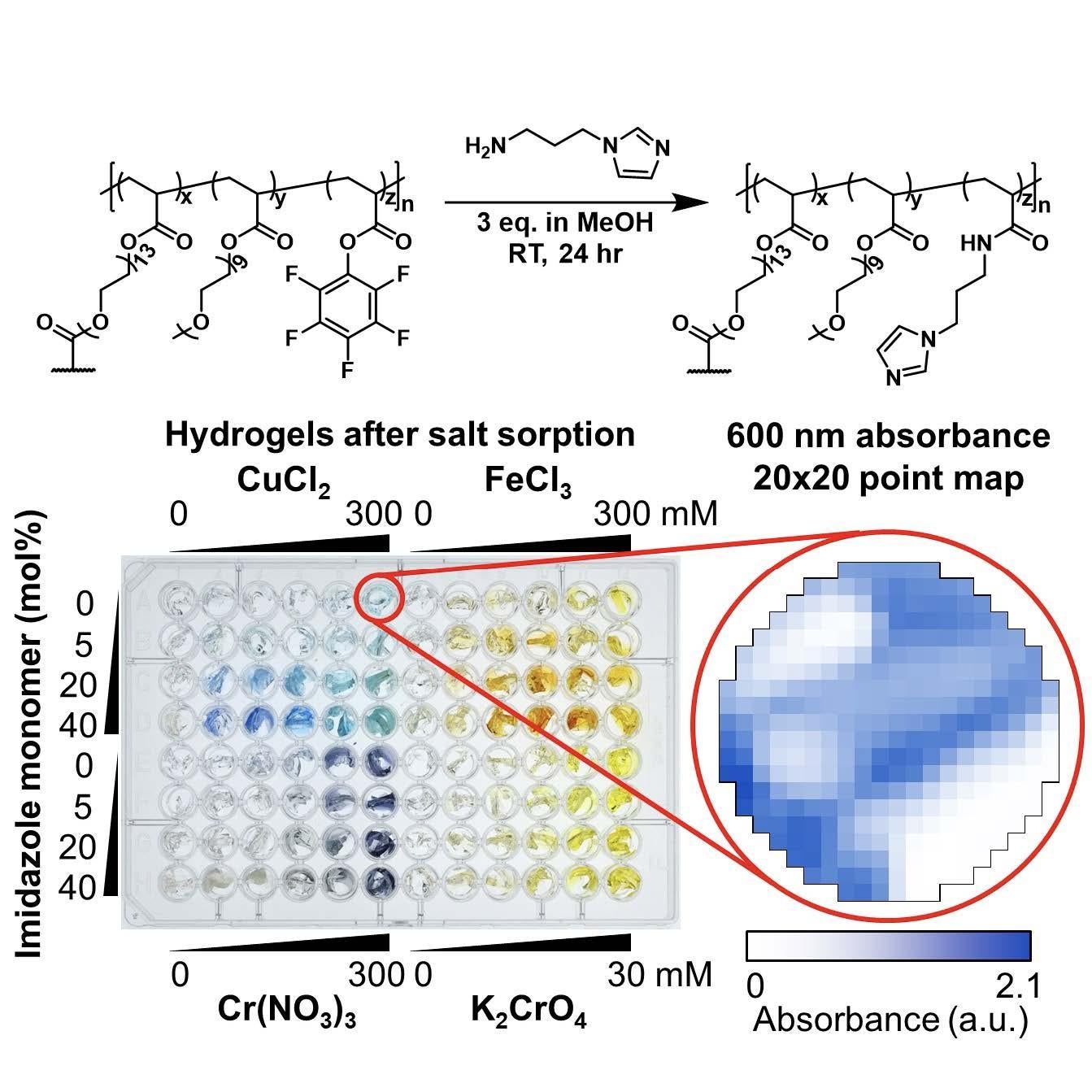
Fig. 5.3. (Left) Picture of 96 well plate containing in situ synthesized hydrogels based on the non-porous UMCP functionalized by imidazoles (to varying monomer fractions). Uptake of transition metal salts of varying concentration is obvious to the naked eye (left) and (right) prototypical example of spatially resolved measurements of absorbance at 600 nm.
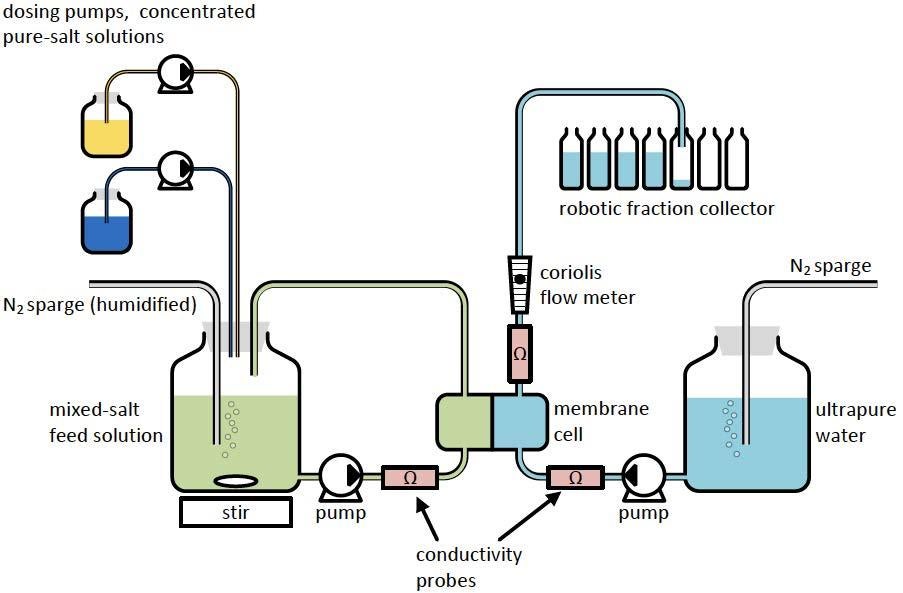
Fig. 5.4. Automated permeation analyzer for single and mixed salt systems. All components are automated and can be controlled and monitored online.
IF, Project 3: Operando Visualization of Membrane Fouling
One key area of interest across the GAPs is identifying membrane functionality that promotes fouling-resistant behavior and improves selectivity. Within the IF, Project 3 will work across GAPs to elucidate new fundamental understanding of membrane fouling with the model systems and UMCP-derived membranes, providing critical chemical and nano- to mesoscale information to inform synthesis and theory efforts. The IF will characterize the processes that control novel membranes through in situ and operando measurements to capture sorption, nucleation, aggregation, specific interactions among membrane foulants, cake/gel layer formation, and decreased macroscopic membrane performance (Su, Crumlin, Katz, Freeman).
M-WET’s groundwork studies to characterize membrane fouling (e.g., Fig. 5.5) reveal the importance of building on Su and Katz’s recent success in applying tender resonant Xray scattering (TReXS) and resonant soft X-ray scattering (RSoXS) and expanding to characterize fouled RO membranes under realistic membrane operating conditions (e.g., hydrated, flowing, pressurized). Scattering will be coupled with element-specific NEXAFS spectroscopy to reveal molecular-level interactions (e.g., ion bridging interactions and speciation changes) in fouling layers (Fig. 5.5d). The IF will develop pressurized crossflow cells for operando scattering (SAXS/WAXS) and spectroscopic measurements (NEXAFS and EXAFS). Although previous work has used X-ray scattering to track mineral nucleation and growth and organic matter fouling, significant tangential flows and higher pressures are needed to mimic ultrafiltration and reverse osmosis conditions. Development of an operando crossflow cell will enable time-resolved scattering measurements with hard and tender X-rays to track fouling mechanisms (e.g., mineral nucleation and growth, organic adsorption/bridging and particle deposition/aggregation) and relate these molecular-level interactions to membrane performance. We will build off M-WET’s previous work on model track-etched membranes fouled with latex beads, where the well-defined form factors of cylindrical pores and spheres allowed scattering profiles to be fit to multiple population models, to advance scattering-based methods of distinguishing between internal and external fouling and to independently track the contribution of each during fouling. Experiments using complex water chemistries within the MFP will reveal synergistic interactions among foulants (e.g., silica and organic foulants) and inform material design in GAP A, identifying membrane functionality and/or chemical speciation that promotes anti-fouling behavior. We will focus on neutral and ionic foulants and surface functionalizations studied in GAP A. Real-time fouling studies will begin with hard X-ray scattering and spectroscopy measurements, which are performed at ambient conditions. In situ resonant scattering (RSoXS and TReXS), pursued simultaneously, will leverage recent developments in vacuum-compatible flow cells.
This complementary set of X-ray spectroscopy and scattering techniques will provide the chemical and spatial sensitivity for real-time tracking of fouling layer buildup and the temporally changing composition and nanoscale distribution within fouling layers (e.g., the amount of Ca2+ or other ions and ion clustering within the fouling layer) as a function of exposure to complex waters across the MFP. Operando nanoscale characterization using pressurized, crossflow cells that mimic macroscopic membrane measurements will provide a bridge between membrane chemistry and performance.
The IF’s operando measurements will be guided by theory and simulation. M-WET has leveraged Su’s experience in direct simulations of NEXAFS spectroscopy and applied the Many-Body X-ray Absorption Spectra (MBXAS) methodology based on density functional theory to understand local environments around specific fouling-relevant species (e.g., calcium-carboxyl interactions). The IF will continue to advance quantum chemical calculations and combine these equilibrium-based calculations with atomistic and coarse-grained dynamic simulations, leveraging expertise in GAPs B and C (Fredrickson, Henkelman, Ganesan) to correlate measured spectroscopic and scattering data to molecular-scale microenvironments and nanoscale phases.
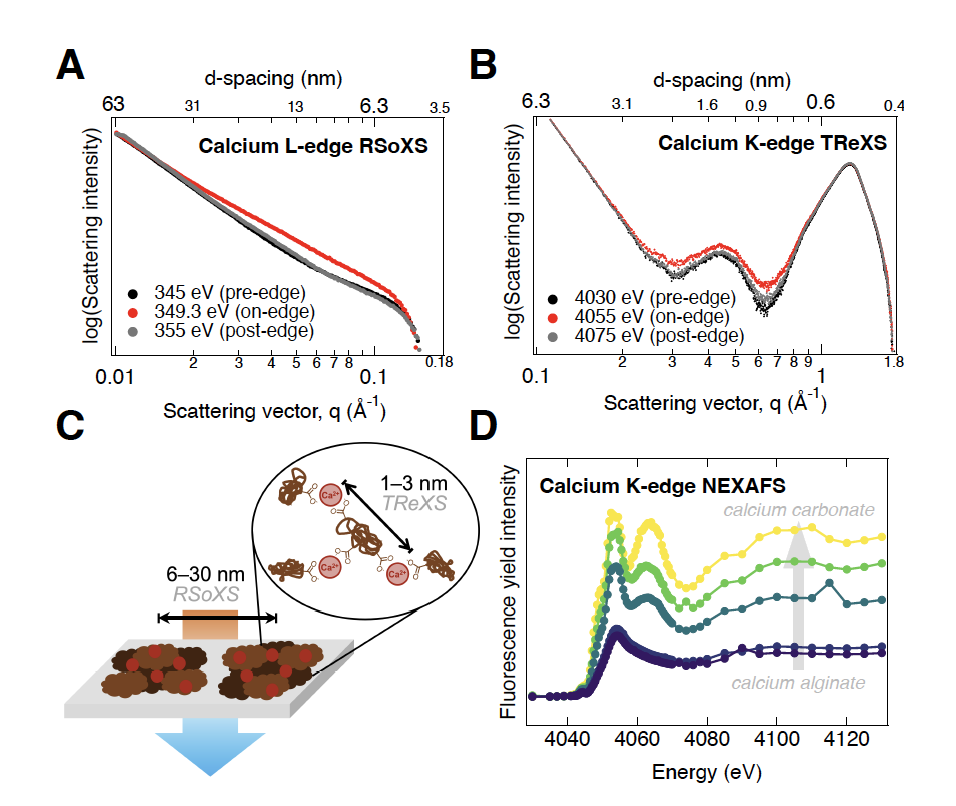
Fig. 5.5. Enhancement of on-resonance scattering intensities at the Ca2+ (a) L-edge and (b) K-edge reveal (c) ion spacing between (RSoXS) and within (TReXS) NOM aggregates on RO membrane surfaces. (d) Ca2+ K-edge NEXAFS spectroscopy shows a shift in fouling mechanism from calcium-carboxyl bridging to calcium carbonate precipitation with increasing CaCO3 oversaturation.
IF, Project 4: Operando Characterization of Assembly Pathways in Integral Asymmetric Membranes
While GAP C will utilize the UMCP block polymer library to understand and develop the formation process of isoporous asymmetric membranes via SNIPS/NIPS, in the IF, Su, Crumlin and Katz will develop the unique and critical operando X-ray scattering tools necessary to track each stage of the SNIPS process, as shown in Fig 5.6. As discussed in GAP C, the process by which block copolymers are processed to form isoporous asymmetric membranes is a non equilibrium process that is empirically optimized for each new chemistry. Via the development of operando sample stages and high sensitivity/speed detectors capable of capturing micro to millisecond snapshots for hard X-ray scattering, the IF will develop tools that can uniquely monitor both the initial solvent casting of the block copolymer micelles and then the non-solvent immersion processes that comprise SNIPS, whose mechanism has heretofore been the subject of intense speculation. The high flux of synchrotron X-rays will provide fast snapshots during the critical 15–60 seconds after solvent evaporation begins during the membrane casting process. The desired 10–100 nm characteristic length scale in the isoporous skin layer is ideal for the length scales that SAXS can probe. Moreover, in situ grazing incidence SAXS (GISAXS) will enable enhanced surface sensitivity, which is relevant to the isoporous layer that exists only in the top few hundred nanometers of the membrane. Further, we will leverage and advance recent developments at the ALS in in situ liquid resonant soft X-ray scattering (RSoXS) to probe polymer micelles and precisely discriminate the spatial extent of the core vs. shell regions of micelles, based on the ability to selectively enhance contrast between polymer blocks by tuning the incident X-ray energy. A second sample cell will be developed to follow the immersion process through which an open porous structure is developed during SNIPS/NIPS. Moreover, by combining GISAXS with transmission SAXS, we can track structure formation of features of up to 100s of nanometers on the membrane surface and through the membrane thickness.
Integral asymmetric isoporous membranes can also be fabricated in a hollow fiber geometry. This geometry is significant because the hollow fiber is one of two (along with flat sheet) dominant form factors used for current membranes. In situ SAXS with the X-ray beam positioned at various distances from the spinning nozzle will provide information on the kinetics of structural rearrangements after extrusion. M-WET will extend our past structure formation of flat sheet membranes to hollow fiber geometries and leverage our access to multiple ALS and NSLS-II SAXS beamlines with varying casting-conditions of pre-formed membranes to connect processing conditions to membrane characteristics. The novel UMCP platform will provide a route towards isoporous membranes with functionalizable hydrophilic pore walls. Synchrotron infrared nanospectroscopy (SINS) and resonant X-ray scattering will be used to map nanoscale morphology with chemical sensitivity, through unique IR signatures of specific functional groups and tunable scattering contrast, respectively. This will also provide a route to spatially resolve the distribution of adsorbed solutes in membranes exposed to complex waters. Thin films cast from micellar solutions have been shown to attain morphologies similar to thicker membranes300, and these thin films will be ideal for transmission RSoXS studies to decipher both the distribution of each domain in a phase separated multiblock copolymer and the impacts of hydration.
GAP C (Sanoja) will provide foundational knowledge of polymer mechanical properties and merge with the operando characterization developments in IF to simultaneously track membrane mechanics and morphology. The ALS has tensile testing stages for the SAXS/WAXS beamline and a vacuum-compatible tensile tester for the RSoXS beamline. These will serve as a starting point for in situ scattering measurements during stretching, which will provide new insights into how morphological parameters, e.g., domain size and separation, influence mechanical behavior. M-WET will further develop custom sample cells specific to isoporous membranes.

Fig. 5.6. Operando scattering can probe (a) micelle structure in solution and (b) self-assembly during solvent evaporation or phase separation during nonsolvent immersion.
Research Highlights - IF (M-WET Years 2018-2021)
A unified two-phase membrane transport model
Reconciles two classical model descriptions of membrane transport for swollen non-porous membrane using the Fluid-solid model, a unified mechanical framework to approach solvent transport.
Salt and ion transport in a series of crosslinked AMPS/PEGDA hydrogel membranes
Fundamental ion transport properties in membranes synthesized with either the same charge density or the same water uptake were characterized. These properties were compared to established models to build structure-property relationships.
Designing Solute-Tailored Selectivity in Membranes
New synthetic strategies to improve membrane selectivity were identified and fundamental design questions were addressed.
Electrodialysis Pretreatment to Improve Boron Removal
Selective removal of divalent cations (e.g., Ca+2) via electrodialysis prior to nanofiltration reduces membrane fouling, which reduces permeate flux decline and improves boron rejection.
Separation Characteristics of Cations and Natural Organic Matter in Electrodialysis
Identifies a hybrid electrodialysis (ED)-Nanofiltration (NF)/reverse osmosis (RO) system and identifies appropriate properties of ion exchange membranes of ED pretreatment for water sources that require little or no desalination but have high NOM concentrations.

